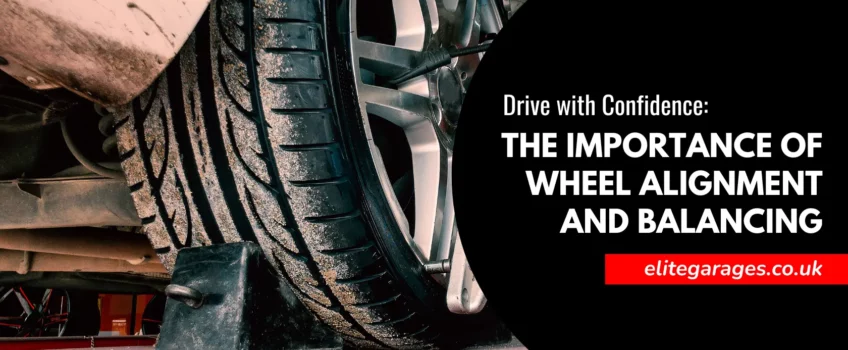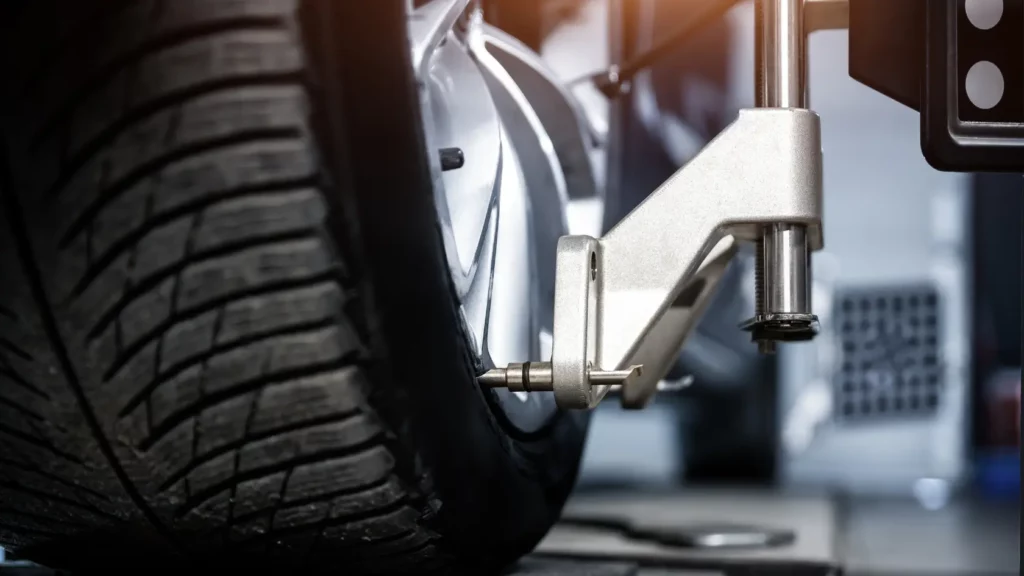
Understanding Wheel Alignment & Wheel Balancing
Have you ever noticed your car pulling to one side while driving? Or perhaps you’ve experienced uneven tyre wear or a vibrating steering wheel. These issues can often be traced back to one culprit: wheel alignment and wheel balancing issues! Wheel alignment and wheel balancing play a crucial role in maintaining your vehicle’s performance, safety, and tyre longevity. In this comprehensive guide, we’ll explore the seven basic steps of wheel alignment, the different types and the benefits of having your wheels aligned and balanced.
The Seven Basic Steps of Wheel Alignment
- Inspection: A skilled technician visually inspects your vehicle’s tyres, suspension components, and steering system to identify any visible signs of wear or damage.
- Air Pressure Check: Tyre air pressure is measured and adjusted according to the manufacturer’s specifications. Proper inflation ensures even tyre wear and optimal performance.
- Suspension Adjustment: Technicians adjust various suspension components, such as camber, caster, and toe, to align them with the vehicle’s specifications.
- Wheel Centering: The wheels are centred using precision instruments to ensure they are aligned with the vehicle’s frame.
- Toe Adjustment: Toe alignment refers to the angle of the tyres relative to each other when viewed from above. Technicians adjust the toe to guarantee parallel alignment, minimising tyre wear.
- Camber Adjustment: Camber alignment relates to the tilt of the tyres when viewed from the front. Technicians adjust the camber to maintain proper tyre contact with the road.
- Caster Adjustment: Caster alignment refers to the angle of the steering axis when viewed from the side. It affects steering stability and returnability. Technicians adjust the caster to optimise handling and stability.
The Three Types of Alignment
Front-end alignment is also known as a “toe and go” alignment. This type focuses on aligning the front wheels, primarily adjusting the toe. It’s suitable for vehicles with a solid rear axle or those with rear suspensions that cannot be easily adjusted.
Four-wheel alignment involves aligning all four wheels, including the front and rear. It ensures proper alignment and balance between all wheels and is suitable for most modern vehicles.
Thrust alignment, also referred to as a “thrust angle alignment,” addresses the vehicle’s thrust line, which is an imaginary line running down the centre of the vehicle. It corrects any misalignment between the rear and front axles.
Also Read: How Do I Know If I Need 2-Wheel or 4-Wheel Alignment?
Wheel Alignment, Tracking & Wheel Balancing: Understanding the Differences
While wheel alignment, tracking, and balancing are all essential aspects of maintaining your vehicle’s performance, they address different issues. Here’s a simple breakdown of each:
What is Wheel Alignment?
Wheel alignment focuses on adjusting the angles of the wheels relative to the vehicle and each other. It ensures optimal tyre contact with the road, even tyre wear, and improved handling. When done properly, it can help enhance safety and fuel efficiency, reducing unnecessary strain on your vehicle’s components.
What is Wheel Tracking?
Tracking is a term commonly used interchangeably with wheel alignment. However, in some cases, tracking may refer specifically to aligning the front wheels’ toe. It’s essential to clarify the specific service offered by your chosen car service centre.
What is Wheel Balancing?
Wheel balancing involves correcting any imbalances in the weight distribution of the wheels and tyres. Technicians use specialised equipment to identify heavy spots and attach small weights to offset them. Balancing reduces vibrations, enhances ride comfort, and prevents premature tyre wear.
The Importance of Wheel Alignment and Wheel Balancing
Proper wheel alignment and wheel balancing offer numerous benefits, including:
- Tyre Safety: Correct alignment reduces uneven tyre wear, ensuring your tyres last longer and maintain optimal performance. Neglecting alignment can lead to premature and uneven tyre wear, compromising your vehicle’s safety.
- Improved Fuel Efficiency: Misaligned wheels cause increased rolling resistance, which forces your vehicle’s engine to work harder and consume more fuel. Proper alignment reduces this resistance, improving fuel efficiency and saving you money at the pump.
- Enhanced Handling and Stability: Accurate alignment improves steering response, handling, and overall stability. It ensures your vehicle tracks straight and handles corners with precision, enhancing your driving experience and safety.
- Reduced Component Wear: Misaligned wheels place additional strain on various suspension and steering components, causing them to wear out prematurely. Regular alignment helps extend the lifespan of these components, reducing the need for costly repairs.
- Ride Comfort: Wheel balancing eliminates vibrations caused by imbalanced wheels, providing a smoother and more comfortable ride for you and your passengers.
What Are The Signs Of Wheel Misalignment?
A wheel alignment service can fix wheels that are sitting at improper angles due to issues with the suspension, which can cause some components to be knocked out of place. It is important to check for tire pressure and wheel alignment issues if you experience any problems. While underinflated tyres and misaligned wheels can cause similar problems, start by checking the tyre pressure. If it’s normal and issues persist, it may be necessary to schedule a two or four-wheel alignment. Keep these six signs or symptoms in mind:
- Vehicle pulls to one side
- Uneven steering wheel
- Loose steering
- Vibrating steering wheel
- Uneven tyre wear
- Tyres that consistently squeal
Wheel Alignment and Wheel Balancing Centres Near Me
Although wheel alignment is generally a simple process, four-wheel alignment must be done precisely for optimal results. Therefore, it is recommended to choose a service centre with modern equipment and highly trained technicians. To provide this service, all Elite Garages offer four-wheel alignment at the following locations:
- Wheel tracking Canterbury
- Maidstone wheel tracking centre
- Mannings Heath wheel tracking centre
- Four-wheel tracking Brighton
- Pulborough wheel tracking centre
- Haywards Heath four-wheel tracking centre
- Salisbury four-wheel tracking
- Four-wheel alignment Bournemouth
- Four-wheel tracking centre Deal
- Portsmouth wheel tracking centre
- Strood car alignment centre
- Caterham car alignment centre
- Four-wheel tracki Shaftesbury
- Four-wheel alignment Eastbourne
- Southampton car alignment centre
- Newport wheel tracking centre
- Shaftesbury car alignment centre
- Wheel Alignment Newport (IoW)
Conclusion
Proper wheel alignment and wheel balancing are critical for maintaining your vehicle’s performance, safety, and tyre longevity. By understanding the seven basic steps of wheel alignment, the different types of alignment, and the differences between alignment, tracking, and balancing, you can make informed decisions about caring for your vehicle. Regular wheel alignment checks, along with proper tyre maintenance and driving habits, will ensure a smooth and safe ride while extending the lifespan of your tyres and reducing the risk of expensive repairs.
Trust our car service centre’s expertise across multiple branches in the UK to provide you with top-notch wheel alignment and a comprehensive range of vehicle services. Drive with confidence and experience the difference that proper wheel alignment and wheel balancing can make!
FAQs
Click the + to read any answer or visit our most FAQ page to review the most frequently asked questions across all our Elite Locations.
If you click on a ‘Category’ or ‘Tag’ link, the page will ‘refresh’ and reload the page showing the top of the page first, you’ll then just need to scroll down to the FAQ section to see the results for the Category or Tag you selected.
While wheel alignment checks should be done at least every 6 months or 6,000 miles, you should get it looked at immediately when you’ve hit a kerb or been in an accident. Incorrect alignment almost certainly leads to uneven tread wear which means you will have to replace your tyres sooner than is actually required.
Four-wheel alignment is the most comprehensive option, ensuring optimal alignment for all four wheels. However, it’s essential to consult with a knowledgeable technician to determine the specific needs of your vehicle.
The three types of wheel alignment are front-end alignment, four-wheel alignment, and thrust angle alignment. Front-end alignments focus on the front wheels, while four-wheel alignments adjust all four wheels. Thrust angle alignments address the vehicle’s thrust line, which is an imaginary line running down the centre of the vehicle.
Yes, misaligned wheels increase rolling resistance, forcing the engine to work harder and consume more fuel. Proper alignment and wheel balancing can help improve fuel efficiency.
Wheel alignment is the adjustment of the angles of the wheels to ensure they are parallel with each other and in line with the vehicle’s frame. Wheel tracking focuses on aligning the front wheels’ toe, while wheel balancing ensures even weight distribution across all tyres and rims.
About Us
Opening Times
Saturday : 8:30–4:00
Sunday : closed
More Information
Contact UsCustomer Information Pack
Check MOT Due Date
Free MOT reminder
Careers
Legal Information
Recent Posts
- Uneven Tyre Wear Explained: Is It Time for a Wheel Alignment Service?
- Is Your Track Rod End Causing Wheel Alignment or Suspension Problems?
- Brake Repairs in Bournemouth: Why Stop-Start Roads Are So Tough on Your Car
- MOT in Dorchester: Keeping the South Coast Safely on the Move
- Car Battery Problems: Don’t Let a Dead Battery Flatten Your Day



